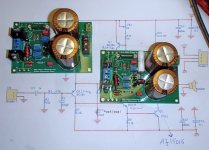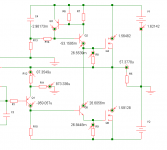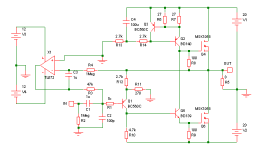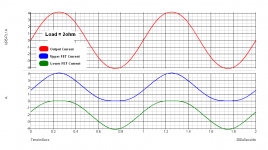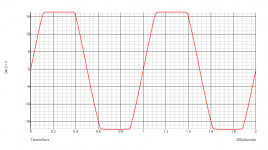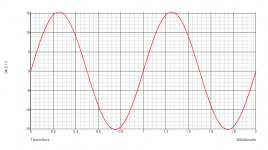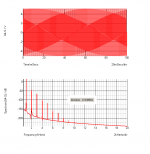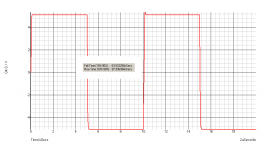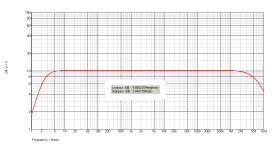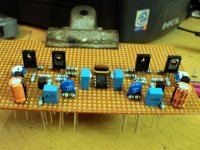Hi Nico, glad to hear of your SMPS experience. (A) because you tried it and (B) because you had positive results. Been thinking about it for a while here because I have half a mind (and some people would say "that's all you DO need") to do a Class A tri-amped system and the SMPS had a substantial economical advantage apart from sound quality.
I have in the archives here somewhere an article by Ben DUNCAN that appeared in Electronics World (the old Wireless World) 15-20 yrs ago. It was specifically about bass response and one of the points he made was that in his experience a switch mode supply gave noticeable advantages in the quality of bass response in at least one of the amps he tried.
In addition to the reduction in noise have you had the chance to A/B the SMPS with the conventional one and come to any conclusions about bass quality?
EDIT......sorry, just re-read your post....I take it your observations on tonal quality apply to the 'bottom end' too..
Cheers, and a Happy Summer Solstice Season to all our members.
Jonathan
I have in the archives here somewhere an article by Ben DUNCAN that appeared in Electronics World (the old Wireless World) 15-20 yrs ago. It was specifically about bass response and one of the points he made was that in his experience a switch mode supply gave noticeable advantages in the quality of bass response in at least one of the amps he tried.
In addition to the reduction in noise have you had the chance to A/B the SMPS with the conventional one and come to any conclusions about bass quality?
EDIT......sorry, just re-read your post....I take it your observations on tonal quality apply to the 'bottom end' too..
Cheers, and a Happy Summer Solstice Season to all our members.
Jonathan
Last edited:
Just getting ready to build a JLH 10 watter and have a few 2N5631 laying around. These are sloooooow at 1mhz, but wondering what you all think... the MJ15003 is a little better at 2mhz (albeit double)
I know I have some 2SC5200's laying around, but would be interested in your opinions anyway on the 2N5631...
Thanks
I know I have some 2SC5200's laying around, but would be interested in your opinions anyway on the 2N5631...
Thanks
Last edited:
10x68000...Dose cobra want to drive his car by capacitor?
You remind me.. I should try with my super cap, 145 Fara 48V. I believe the hums can be blow to Mars with it. But what transformer should I use?
hehe
I also have a lot of (about 20pcs) 63V 68000 uf panasonic capacitor. They are really great for audio amplifiers. But I don't plan to use them for my JLH since it's too large. I also don't have plan to list them for sell, because the shipping cost is too high. If one day I build a 80W JLH they'll have place to go.
I also have a lot of (about 20pcs) 63V 68000 uf panasonic capacitor. They are really great for audio amplifiers. But I don't plan to use them for my JLH since it's too large. I also don't have plan to list them for sell, because the shipping cost is too high. If one day I build a 80W JLH they'll have place to go.
okei
100mm height x 63mm dia. as big as my daughter's milk bottle
hehe
Hi Nico,
EDIT......sorry, just re-read your post....I take it your observations on tonal quality apply to the 'bottom end' too..
Cheers, and a Happy Summer Solstice Season to all our members.
Jonathan
Hi Johnathan,
My brother was visiting me since Friday (he is also an music addict) and we where listening particularly to the JLH because he has never heard class A and he was pretty much sold on class A for his future amplification system.
Once we both got used to JLH, we switched power supplies every few hours and the idea was to get used to the sound of each power supply and then listened to the same music again and discuss what differences we felt was audible.
In all listening tests over three days, the SMPS outperformed the conventional transformer in terms of tonal clarity at all frequencies and all levels below audible distortion, this was in fact the most obvious and immediate observation.
Please keep in mind that the 40 000uF rail capacitors remained on the board both when using transformer and rectifier bridge or the SMPS.
The transformer is rated at 360VA and the SMPS is rated at 300 watt
Last edited:
if you throw away all the copper and all the steel, there is insufficient PSU left to power the project. No Power = No Noiseinstead of this, give us some figures.
Hi Andrew, I don't know if you remember my test for power supply, it involves capacitively coupling a head phone and listening to the rails for any audible hum and noise at full load. On this SMPS there is none.
I have built many JLHs and by far this is my favorite amplifier. I have tried TIP3055 and 2SC5200 as output devices, both worked well in the same circuit and I am extremely satisfied with this amp!
Now I am building another JLH(Actually DoZ(modified(CCS))); It's the FET version posts that made me want try it with FETs. I have some spare Laterals in stock. Last night passed simulating the planned circuit. Here are the sim results. The circuit seems to have the potential to become a great sounding amp. Got all the parts and gonna assemble it tonight.
Some observations:
1. In the BJT version the bandwidth is ~2MHz, in the Lateral one it is ~5.5MHz(expecting oscillation and gate stoppers).
2. The rise time and fall time are respectively one sixth and half of that of the BJT version.
3. The BJT version had 0.2% distortion at 10VPP into 8ohm; the Lateral has 0.16%, with decreased higher order harmonics.
4. With +-20V supply, the BJT version has maximum voltage swing of 33V(+-16.5V), the Lateral has 30V(+-15V).
5. Clipping seems as good as the BJT one.
6. Maximum current output. This is where I am surprised. The circuit seems to be able to deliver current more than 2.5 times Iq. Initially I thought I made a mistake. But after many hours of experimenting no errors were found. I ran the sim at 1.6A of Iq, both the FETs can reach 4A when the load is down to 2ohm. I expected assymetrical clipping, as usual with the BJT version. At 1.6A Iq, the voltage at the gates of the FETs is ~2.7V.
Curious and excited! I'll upload test results of the build ASAP.
Now I am building another JLH(Actually DoZ(modified(CCS))); It's the FET version posts that made me want try it with FETs. I have some spare Laterals in stock. Last night passed simulating the planned circuit. Here are the sim results. The circuit seems to have the potential to become a great sounding amp. Got all the parts and gonna assemble it tonight.
Some observations:
1. In the BJT version the bandwidth is ~2MHz, in the Lateral one it is ~5.5MHz(expecting oscillation and gate stoppers).
2. The rise time and fall time are respectively one sixth and half of that of the BJT version.
3. The BJT version had 0.2% distortion at 10VPP into 8ohm; the Lateral has 0.16%, with decreased higher order harmonics.
4. With +-20V supply, the BJT version has maximum voltage swing of 33V(+-16.5V), the Lateral has 30V(+-15V).
5. Clipping seems as good as the BJT one.
6. Maximum current output. This is where I am surprised. The circuit seems to be able to deliver current more than 2.5 times Iq. Initially I thought I made a mistake. But after many hours of experimenting no errors were found. I ran the sim at 1.6A of Iq, both the FETs can reach 4A when the load is down to 2ohm. I expected assymetrical clipping, as usual with the BJT version. At 1.6A Iq, the voltage at the gates of the FETs is ~2.7V.
Curious and excited! I'll upload test results of the build ASAP.
Attachments
Last edited:
- Home
- Amplifiers
- Solid State
- JLH 10 Watt class A amplifier
